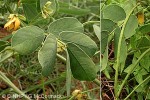Cook Islands Biodiversity Database
Species Page
Senna obtusifolia
Pī ‘Aungakino (MK)Sicklepod
Multimedia & Additional Resources
| Type | Description | Download |
| Leaves, flower and fruits | 55KB |
General Information
Cook Islands Distribution
| Southern Group: Present Makatea: Present | ||||||||
RR |
MG |
AT |
MK |
MT |
AK |
PL |
TK |
MN |
- |
- |
- |
++++ |
- |
- |
- |
- |
- |
| Northern Group: - | |||||
TN |
MH |
RK |
PK |
NS |
SW |
- |
- |
- |
- |
- |
- |
Scientific Taxonomy
Senna obtusifolia Linnaeus
SYNONYMS: Cassia obtusifolia; Cassia tora [sensu Hawaiian bot.]
TAXONOMY: PLANTAE; ANTHOPHYTA (=Angiospermae); MAGNOLIOPSIDA (=Dicotyledones); ROSIDAE; Fabales (Legumes); CAESALPINIACEAE
More Information
SIGNIFICANCE NOTES -
POSITIVE SIGNIFICANCE: Weed (Mauke)
NEGATIVE SIGNIFICANCE: Weed - very serious (Mauke only). Comments: The most widespread weedy shrub on Mauke. Forms very dense thickets and is very difficult to remove. This plant is recorded on Mauke only and every effort should be made to prevent it accidentally spreading to other islands.
IDENTIFICATION: An erect annual shrub-like herb to 2.5m. LEAVES foul smelling; alternate, compound, with 3-pairs of leaflets. LEAFLETS oval widest toward tip, to 6x3cm, tip round, base very unequal. STIPULES 2, slender to 15x2mm. FLOWERS in leaf-axis, 1-2, pale yellow, 2cmØ, 5 petals to 10cm. FRUIT slender 4-angled pod to 15cmx5mm, sickle-shaped; 20-40 seeds; splits when ripe. SEEDS flattened, glossy, brown, to 5mm.
GENERAL NOTE: Declared a serious noxious weed in Queensland. Although not normally eaten by any domestic stock, the seed-pods are sometimes eaten by cattle and horses and it is thus spread from property to property. Control by slashing with blunt-blade slasher to shatter stems - it reshoots after sharp slashing; herbicides; dense grass-cover prevents Sicklepod seed germination and hastens seed decomposition. [DNR Facts, pest series, Dept. Natural Resources, Queensland Gov.]
Vouchers & References
Vouchers:
None Recorded.
References:
p.700 Wagner et al.- Flowering Plants of Hawaii
p.422 Neal - In Gardens of Hawaii
p.1075 Royal Hort. Soc. Index of Garden Plants
p.3/110? A.C.Smith - Flora Vitiensis Nova
Data Update History (information):
zTX, zB02, zM02, zD02
Web Resources
Citation Information
McCormack, Gerald (2007) Cook Islands Biodiversity Database, Version 2007.2. Cook Islands Natural Heritage Trust, Rarotonga. Online at http://cookislands.bishopmuseum.org. ![]()
Please refer to our use policy.

